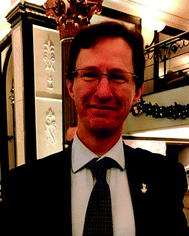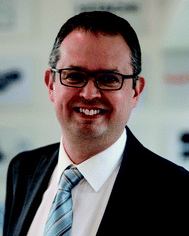Supramolecular chemistry anniversary
David B.
Amabilino
 a and
Philip A.
Gale
a and
Philip A.
Gale
 b
b
aSchool of Chemistry & The GSK Carbon Neutral Laboratories for Sustainable Chemistry, The University of Nottingham, Triumph Road, Nottingham NG7 2TU, UK. E-mail: david.amabilino@nottingham.ac.uk
bSchool of Chemistry (F11), The University of Sydney, NSW 2006, Australia. E-mail: philip.gale@sydney.edu.au
In 1967, Charles J. Pedersen published a communication and a paper in J. Am. Chem. Soc.1,2 – the first reports of the metal ion complexation properties of crown ethers. This year, 2017, marks the fiftieth anniversary of this landmark work and this themed issue of Chemical Society Reviews celebrates Pedersen's achievements and the fifty years of supramolecular chemistry that followed. In fact, Pedersen's great discovery is elegantly recalled for us by Reed Izatt (DOI: 10.1039/C7CS00128B) in this issue, and put into the context of the articles that follow. This issue is also special because many of the reviews have been co-authored by leading groups in the field. Our intention was to create a series of reviews that bring researchers together to provide definitive coverage of contemporary supramolecular chemistry. Of course, what we didn't know when planning this issue was that the 2016 Nobel Prize in Chemistry would be awarded to Jean-Pierre Sauvage, J. Fraser Stoddart and Ben Feringa for their design and construction of molecular machines. We have much to celebrate in the achievements of now all six Nobel prize winners in this area of chemistry and the achievements of the community as a whole.
Who better to pose the question “Supramolecular Chemistry: Where From? Where to?” than the Nobel Laureate Jean-Marie Lehn, who has been kind enough to introduce us (DOI: 10.1039/C7CS00115K) to this special issue. Since his coining of the term, the scope is perhaps even broader than envisaged initially, and the field has grown to encompass a range of non-classical non-covalent interactions, dynamic covalently bonded structures, dissipative assembly and complex systems. 2017 also marks 30 years since the Nobel Prize for Chemistry was awarded to Charles J. Pedersen, Donald J. Cram and Jean-Marie Lehn “for their development and use of molecules with structure-specific interactions of high selectivity” and an indication of just how far the field has come is in the practical applications that have emerged, as highlighted expertly by Igor Kolesnichenko and Eric Anslyn (DOI: 10.1039/C7CS00078B).
Macrocyclic chemistry continues to be an important pillar of supramolecular chemistry and the history of macrocycles from these relatively floppy beginnings to more rigid cyclophanes is surveyed up to date by Zhichang Liu, Siva Krishna Mohan Nalluri and Nobel Laureate J. Fraser Stoddart (DOI: 10.1039/C7CS00185A). Crown ethers continue to play important roles in sensing applications and Jun Li, Dajeong Yim, Woo-Dong Jang and Juyoung Yoon cover this topic in their review on recent progress in the design and applications of fluorescence probes containing crown ethers (DOI: 10.1039/C6CS00619A).
Three articles especially show the structural importance determined by the non-covalent bond in condensed phases. The solid state is unparalleled in the precision it provides concerning the structure of complexes formed between molecules, as Kari Rissanen shows us in his review on the crystallography of encapsulated molecules (DOI: 10.1039/C7CS00090A), whilst the structures of assemblies of molecules at solid surfaces are the topic of Kunal Mali, Nicholas Pearce, Steven De Feyter and Neil R. Champness' review, “Frontiers of supramolecular chemistry at solid surfaces” (DOI: 10.1039/C7CS00113D). Supramolecular Materials are introduced in a Tutorial Review that covers assembly in soft materials including gels and liquid crystals (DOI: 10.1039/C7CS00163K) from David Amabilino, Dave Smith and Jon Steed.
Wenqi Liu, Soumen Samanta, Bradley Smith and Lyle Issacs have looked at synthetic mimics of biotin/(strept)avidin in their review (DOI: 10.1039/C7CS00011A), which highlights recent advances in the development of high affinity synthetic association partners that function in water or biological media. The theme of supramolecular chemistry in aqueous environments continues with discussion of the aqueous supramolecular chemistry of cucurbit[n]urils, pillar[n]arenes and deep-cavity cavitands in the review by James Murray, Kimoon Kim, Tomoki Ogoshi, Wei Yao and Bruce Gibb (DOI: 10.1039/C7CS00095B).
Supramolecular chemistry facilitating the transport of anions across lipid bilayers and cell membranes, and their potential application in the treatment of disease is the topic of Phil Gale, Jeff Davis and Roberto Quesada's review on anion transport and supramolecular medicinal chemistry (DOI: 10.1039/C7CS00159B). Bioinspired assembly of small molecules in cell milieu is discussed by Huaimin Wang, Zhaoqianqi Feng and Bing Xu in their review (DOI: 10.1039/C6CS00656F).
Li-Jun Chen, Hai-Bo Yang and Mitsuhiko Shionoya focus on the assembly of chiral metallosupramolecular architectures in their article (DOI: 10.1039/C7CS00173H) whilst Larissa von Krbek, Christoph A. Schalley and Pall Thordarson look at the fundamentals of assessing cooperativity in supramolecular systems in their review (DOI: 10.1039/C7CS00063D). Gonen Ashkenasy, Thomas Hermans, Sijbren Otto and Annette Taylor discuss systems chemistry in their review (DOI: 10.1039/C7CS00117G).
The synthesis of interlocked species using metal ion templates is the subject of James Lewis, Paul Beer, Steve Loeb and Steve Goldup's review (DOI: 10.1039/C7CS00199A), whilst Salma Kassem, Thomas van Leeuwen, Anouk S Lubbe, Miriam R. Wilson, Nobel Laureate Ben Feringa, and Dave Leigh discuss the synthesis and behaviour of artificial molecular motors in their article (DOI: 10.1039/C7CS00245A).
We owe a debt to all those who have dedicated their precious time to contribute to this unique collection of remarkable insights, visions and overviews. Their engagement in the project is an indication of the positive spirit that surrounds this creative area of chemistry, which no matter how one cares to define in terms of age, is undoubtedly young and with a full, exciting and enthralling life of scientific adventure before it.
Notes and references
- C. J. Pedersen, J. Am. Chem. Soc., 1967, 89, 2495 CrossRef CAS
.
- C. J. Pedersen, J. Am. Chem. Soc., 1967, 89, 7017 CrossRef CAS
.
| This journal is © The Royal Society of Chemistry 2017 |


